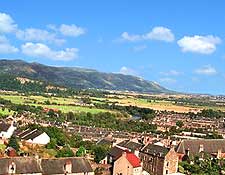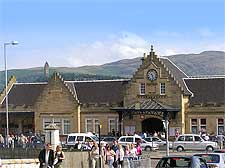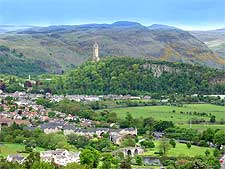Stirling History Facts and Timeline
(Stirling, Scotland, UK)

Stirling's strategic location means that it has been an important settlement throughout Scottish history. Its earliest origins are thought to date back to prehistoric times. In the Kings Park area of the town, there's evidence of prehistoric carvings.
The history of present-day Stirling can really be said to date back to the 12th century. Much of this 'Old Town', known variously as Strivelyn or Striveling, still survives today.
Medieval Era
At some stage during the 11th century, a castle was built on a rocky outcrop here. It was still very much a rudimentary affair, built from wood and surrounded by an earth rampart. A small town grew up on the slopes around the castle. Then, in 1124, King David I made Stirling a royal burgh. A merchants' guild was formed and the town's affairs started to be run by a provost. The Church of the Holy Rude was founded at this time as the parish church of Stirling. Much of this original church was to be later destroyed by fire.

Local history is closely tied up with the turbulent events that have surrounded its castle. It was believed that whoever held control over Stirling Castle held control over the whole of Scotland - hence it being called the key to Scotland. In the late 13th century, the wooden castle was rebuilt in stone. In 1296, it was seized by King Edward I. However, it was wrested back just a year later by William Wallace, leader of the Scottish forces. In 1304, after a Scottish defeat, English forces took the castle again. Then came Bannockburn - the battle fought by William Wallace and Robert the Bruce in 1314, which lives on in history. The Scots were successful, for now at least. During the 14th century, however, Stirling Castle was besieged several times.

From the Stuarts to the Present Day
During the 15th and 16th centuries, steps were taken to rebuild the Church of the Holy Rude. By 1414, its nave, south aisle, arches, roof and tower had been completed. Later work was continued under King James IV. Interestingly, the church is the only surviving example, other than Westminster Abbey, to have held a coronation. In 1543, Mary, Queen of Scots was crowned here. So too was her son James VI of Scotland, some 24 years later. The young King James was educated at Stirling Castle.
In the 17th century, however, circumstances conspired to reduce the town's importance. In 1603, the death of Queen Elizabeth I of England meant that James VI also became James I of England. He subsequently moved to England and, without its royal resident, Stirling Castle was used as a barracks.

At the start of the 18th century, Stirling was still a relatively small town, although there were signs that it was starting to expand beyond its original boundaries. A number of large mansions were built south of the burgh. Many of its townsfolk were engaged in the woollen industry or carpet weaving. By the time Victoria came to the throne, Stirling had also begun to develop as a tourist centre.
The railway reached here in 1848 and from then, the town began to grow apace. New houses were built in the west of the town to meet the demands of a newly emerging middle class. This was also a time of fervent nationalism, not just in Scotland, but all over the world. In 1869, the Wallace Monument was built in memory of this rebel leader who had fought so close to Stirling. Later additions to the building included marble sculptures of other Scottish heroes, such as Robert the Bruce. Of note, Stirling was made a city in 2002.
 Stirling's strategic location means that it has been an important settlement throughout Scottish history. Its earliest origins are thought to date back to prehistoric times. In the Kings Park area of the town, there's evidence of prehistoric carvings.
Stirling's strategic location means that it has been an important settlement throughout Scottish history. Its earliest origins are thought to date back to prehistoric times. In the Kings Park area of the town, there's evidence of prehistoric carvings. Local history is closely tied up with the turbulent events that have surrounded its castle. It was believed that whoever held control over Stirling Castle held control over the whole of Scotland - hence it being called the key to Scotland. In the late 13th century, the wooden castle was rebuilt in stone. In 1296, it was seized by King Edward I. However, it was wrested back just a year later by William Wallace, leader of the Scottish forces. In 1304, after a Scottish defeat, English forces took the castle again. Then came Bannockburn - the battle fought by William Wallace and Robert the Bruce in 1314, which lives on in history. The Scots were successful, for now at least. During the 14th century, however, Stirling Castle was besieged several times.
Local history is closely tied up with the turbulent events that have surrounded its castle. It was believed that whoever held control over Stirling Castle held control over the whole of Scotland - hence it being called the key to Scotland. In the late 13th century, the wooden castle was rebuilt in stone. In 1296, it was seized by King Edward I. However, it was wrested back just a year later by William Wallace, leader of the Scottish forces. In 1304, after a Scottish defeat, English forces took the castle again. Then came Bannockburn - the battle fought by William Wallace and Robert the Bruce in 1314, which lives on in history. The Scots were successful, for now at least. During the 14th century, however, Stirling Castle was besieged several times.
 At the start of the 18th century, Stirling was still a relatively small town, although there were signs that it was starting to expand beyond its original boundaries. A number of large mansions were built south of the burgh. Many of its townsfolk were engaged in the woollen industry or carpet weaving. By the time Victoria came to the throne, Stirling had also begun to develop as a tourist centre.
At the start of the 18th century, Stirling was still a relatively small town, although there were signs that it was starting to expand beyond its original boundaries. A number of large mansions were built south of the burgh. Many of its townsfolk were engaged in the woollen industry or carpet weaving. By the time Victoria came to the throne, Stirling had also begun to develop as a tourist centre.